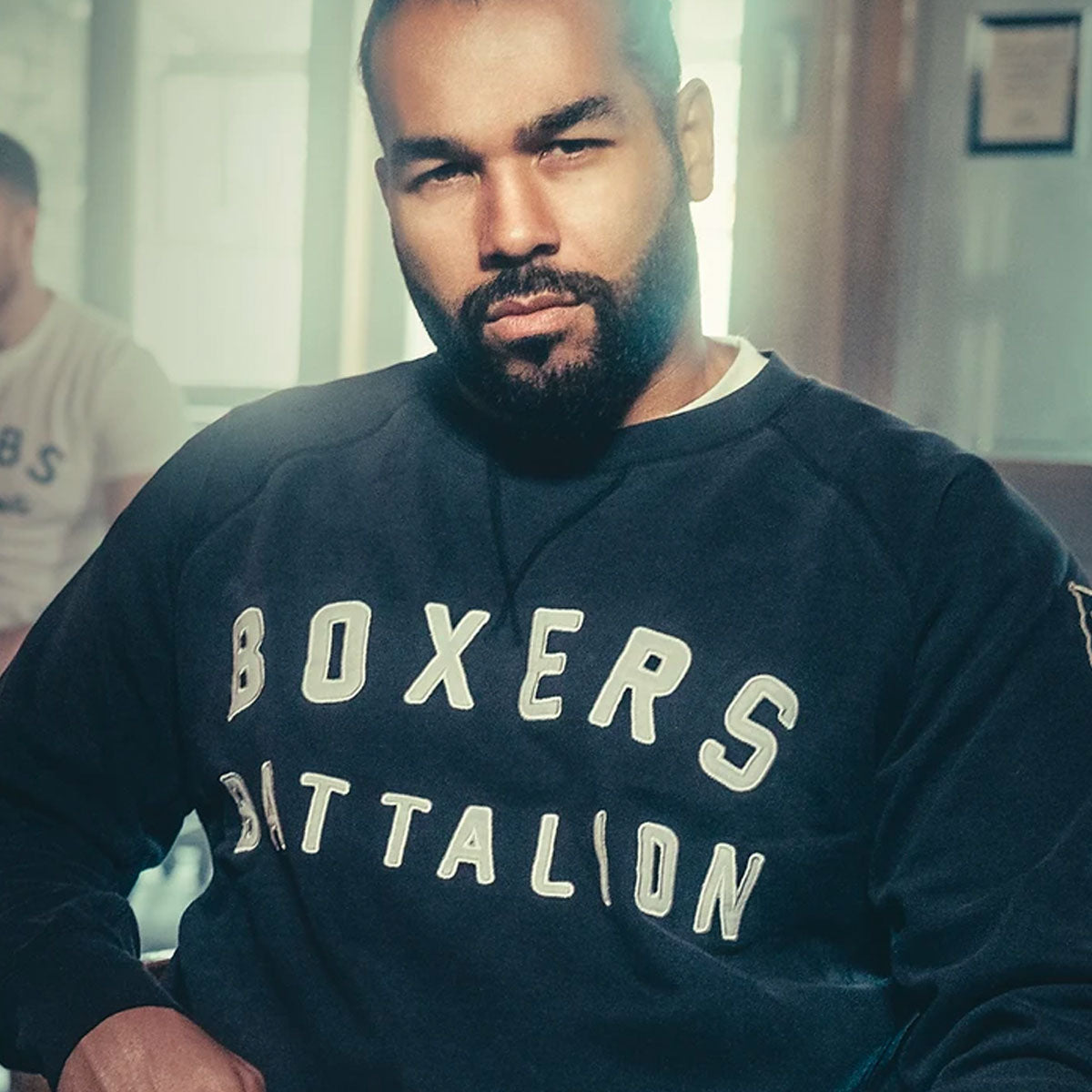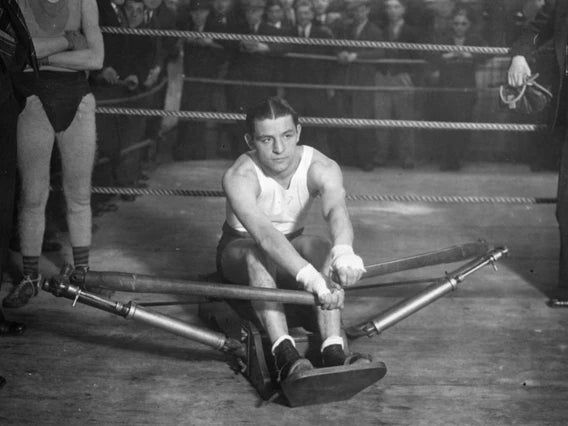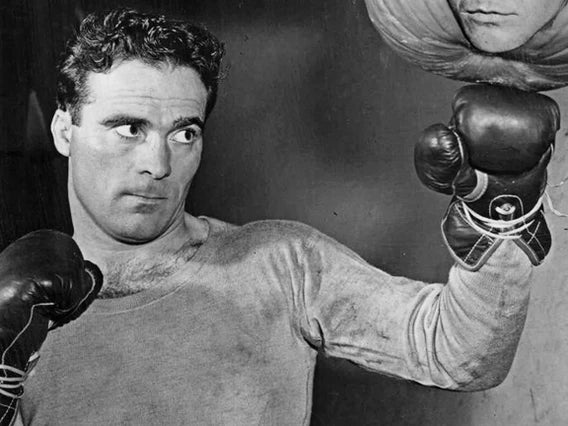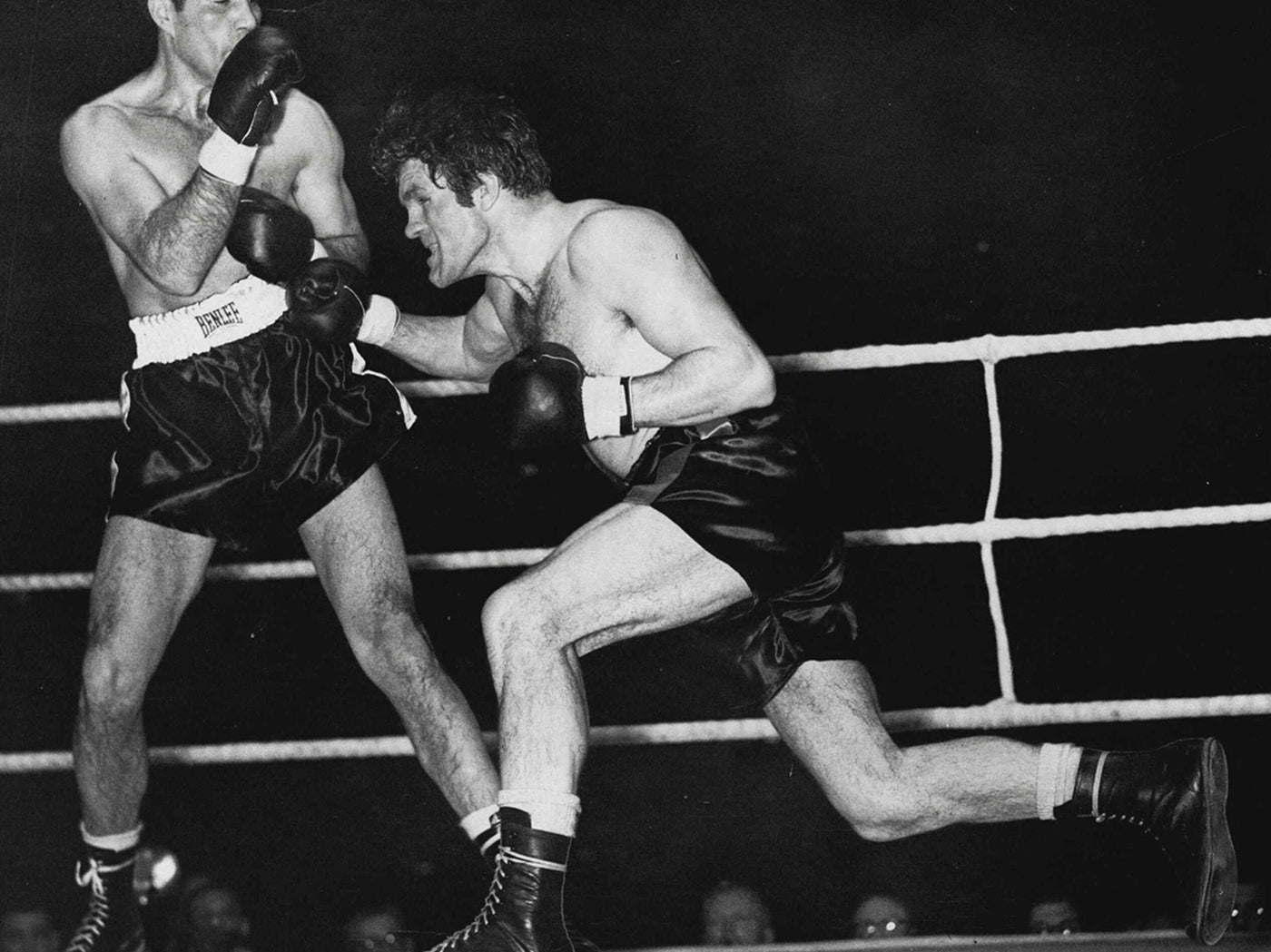By Paul Zanon
He turned professional at 14 years of age, was world champion by 20 and lived a furious life inside and out of the ring. Ladies and gentlemen, I present you Judah Bergman. You perhaps know him as Jack ‘Kid’ Berg.
Born on 28 June 1909 in Stepney, he was the son of Orthodox Jews, Judah Sr, a tailor by trade and his mother, Mildred who was a migrant from Odessa, USSR now known as Ukraine. He was the fourth of seven children and had four sisters Rachel, Sadie, Rebecca, Sarah, and two brothers, Willie and Teddy.

Jack 'Kid' Berg with mother and father
Growing up in extreme poverty in a crowded two-bedroom flat, with very little formal education, he did what many attempted to do in impoverished areas - he fought his way out. His father earned two pounds per week and wanted young Berg to be a cabinet maker. Not really taken in by the trade, Berg decided he preferred nailing opponents instead of wooden furniture and started fighting in organised contests at the age of 11, to the great displeasure of his father.
Twenty days before his fifteenth birthday, on 8 June 1924 Berg had his debut against Johnnie Gordon at Premierland, Whitechapel, stopping his fellow Londoner in the eighth of a scheduled 10 round contest. He adopted the ‘Kid’ moniker from fellow British-Jewish world champion, Ted ‘Kid’ Lewis.
When he returned home his father spotted Berg’s black eye and gave him a roasting. When he then presented his father with the money from his first fight, he turned to Berg and said, ‘Son – Go back and fight again!’
Berg’s first 36 fights took place at Premierland, which was East London’s largest boxing venue at the time, earning him a 32-2-2 record within 17 months of turning pro. The two losses were against solid Yorkshireman, Johnny Cuthbert, but within his 32 wins Berg avenged the losses.
Berg’s first fight away from Premierland was on 11 February 1926 at the Albert Hall, London against wily Bethnal Green boxer, Harry Corbett who went on to amass 146 wins in his 223 professional contests. The pair fought just below the super featherweight limit and after 15 rounds Corbett walked away the victor with a points win. Within Berg’s next seven fights he drew with Corbett and then avenged the loss.
By February 1928, still only 17 years old, Berg was now a natural lightweight with a resume of 53-3-3, and headed to the US to establish himself as a world level contender. To all intents and purposes, as with many green British fighters travelling abroad back in the day, Berg was considered to be a sacrificial lamb by the US onlookers as he stepped through the ropes against Colombian born Panamanian, Pedro Amador. ‘Kid Chato’ as he was known, boasted a record of 35-11-9, with most of those losses and draws highly debated due to being a foreigner on US soil. Amador was a serious contender and one very tough hombre.
Living up to his ‘Windmill’ moniker, on 28 May 1928 at Madison Square Garden, 18-year-old Berg, swarmed Amador from the opening stanza, suffocating his opponent with every punch in the book. By the final bell, Berg took a one-sided points decision at a pace more accustomed to a flyweight. The Amador victory earned him a number of return visits to the US. In fact, over the next few years, he would fight a further 75 times across the pond and from 1931 relocated Stateside for the balance of his boxing career. The Americans loved him and christened him with their own nickname of ‘Whirlwind,’ with many comparing him to Harry Greb. In addition, he was now under the strict tutelage of legendary trainer Ray Arcel, proving to everyone, Jack ‘Kid’ Berg was not there to make up the numbers.

Four fights after the Amador bout, on 26 July 1928 the East Londoner took on Pennsylvanian born contender, ‘The Fargo Express,’ Billy Petrolle at the Mills Stadium Chicago, with the pair fighting to a draw. Four weeks later, they clashed again, but this time Petrolle steam rolled Berg. The Chicago Tribune stated, "Berg took a monumental beating. He was down nine times in the first round and once in the third." Berg who was openly a ladies’ man, blamed the loss on a particular encounter with a lady the night before. Or in his own words, “I was messin around with a broad.” This was Berg’s first stoppage loss in 70 fights.
Berg’s love of women used to drive his trainer, Ray Arcel up the wall, convinced his charge could have been a far more successful fighter if he had better discipline in the bedroom. In a piece written by Jonathan Rendall in 2005, he quoted Arcel’s recollections. “Not only could he fight, but he thought he was God’s gift to the ladies. You had to watch him like a hawk.”
Berg bounced back with gusto from the Petrolle defeat and over the next three and a half years was undefeated in 32 contests, collecting some very respected scalps along the way including Alf Mancini and Tony Canzoneri.
The Canzoneri fight on 17 January 1930 in front of 18,852 at Madison Square Garden was a graduation of sorts for Berg. A final steppingstone before world title recognition. After 10 rounds, Berg walked away with a split decision win, getting plaudits from the US media. The New York Times reported: “Fighting one of the most important ring struggles of his career, Berg rose to the occasion by giving Canzoneri one of the worst beatings he has ever experienced and winning the decision to the complete satisfaction of the crowd which jammed the Garden.”

Only four weeks after the Canzoneri victory, Berg raised the bar once again, taking on reigning National Boxing Association world super lightweight title champion, Mushy Callaghan on 18 February 1930 at the Royal Albert Hall, London. Berg had already fought Callaghan on 24 July 1929 at Ebbets Field, Brooklyn, walking away with a comfortable points victory over 10 rounds. However, they previously fought at welterweight, whereas now they both weighed in at 137lbs, which played in Berg’s favour as the faster and more aggressive fighter.
After grinding Callaghan down for nine rounds, Berg knocked out the New Yorker in the tenth and thus becoming the new world super lightweight champion. The contest was beautifully captured in pastels by artist Bob Carson.
After a number of defences of his strap, on 7 August 1930 at the Polo Grounds in Harlem, New York, Berg secured a split decision victory over 10 rounds against future hall of famer, Eligio Sardiñas Montalvo, better known as Kid Chocolate. Berg collected a staggering $66,000 from the victory, setting him up for life. The Cuban, who was destined for greatness, was unbeaten in 56 fights and would go on to become a multi-weight champion, losing only 10 of his 152 fights. Many rated this fight as Berg’s best ever performance as a professional.
Being God’s gift to ladies also came with its challenges, one of them being monogamy. The handsome and sartorially exquisite Berg married American Eleanor Kraus in 1930 and by November 1931, said relationship was over. To say he was active during that time would be a mild statement, as a number of women claimed they were in a relationship with him, each attempting to claim compensation from the wealthy boxer. He remarried in 1933 to a dancer called Bunty Pain and then married one final time on 20 February 1943 to Moyra Smith.
Back to the boxing. On 24 April 1931, Berg fought old foe, Tony Canzoneri at the Chicago stadium, looking to successfully defend his world title for the tenth time. However, this time far more was at stake, as the world lightweight and welterweight titles were on the line. Unfortunately, an ill prepared and weight drained Berg barely landed a punch on Canzoneri. After taking a one-sided beating for two rounds, Berg was stopped at two minutes and 23 seconds of the third. Associated Press stated that the American, “Won the first two rounds and battered Berg to defeat in the third round without being in the slightest danger himself.”
Six months and six victories later, Berg and Canzoneri met for the third and final time to conclude business. Despite giving a much better account of himself, Berg lost a unanimous points decision over 15 rounds at the Polo Grounds, New York. However, the fight did finish with an air of controversy. In the eighth round Berg went down from a foul blow, but the American referee, Patsy Haley ruled it a knockdown. If the bout had taken place in its original intended venue of London, the result may have differed.
Three fights later, on 1 April 1932 the self-proclaimed ‘Cockney-Jew’ drew against Boston’s Sam Fuller at Madison Square Garden. The pair met again seven weeks later, but this time the world junior welterweight title was on the line. Unfortunately for Berg, after 12 hard fought rounds Fuller got the nod from two of the judges with a split decision victory, albeit, Berg “got most of the cheers as the pair left the ring." (New York Times)
On 18 July 1932, Berg took on Kid Chocolate again, but this time at the Madison Square Garden Bowl in Queens in front of a 10,000 strong crowd. Once again the pair produced a barnburner of a fight, with Berg walking away with a majority decision. Three months later Chocolate beat Fidel LaBarba to become world junior lightweight champion. Unfortunately the two ‘Kids’ never had the chance to battle over world honours.

'Kid' Chocolate vs Jack 'Kid' Berg vs (2nd bout)
From here on, Berg’s career had a roller coaster motion to it. In his next seven fights he lost three, twice to Cleto Locatelli, once on British soil and once in the US. Then, in his next six fights he lost one by third round KO to Liverpudlian Jimmy Stewart, but bounced back three fights later beating Harry Mizler and in doing so becoming the British lightweight champion.
After a four round demolition of Fred Bastin, Berg fought Frenchman Gustave Humery three times back to back in the opening months of 1935, winning the first encounter by eighth round knockout and losing the next two on points. Humery would go on to become European lightweight champion two years later.
Berg finished off the year with three wins on the bounce, followed by three consecutive defeats to kickstart 1936, which included a points loss in Johannesburg against undefeated South African, Laurie Stevens for the Commonwealth lightweight strap in front of 14,000 people. Despite announcing his retirement following his third straight defeat, he was back in the ring five months later on 24 January 1937, beating Ivor Pickens on points.

Gustave Humery vs Jack 'Kid' Berg (1st bout)
Berg fought 12 times in 1937, all in the UK, winning nine, losing one and drawing two against domestic level opposition. From February 1938 to August 1939, East London’s favourite fighting son fought 25 times, with 24 of the contests on US soil and one in Bermuda against fellow Brit, Marine Bunker (great name), and in doing so walking away with the Bermuda welterweight title. Despite winning 21, losing three and drawing one, it was evident that Berg, now weighing north of welterweight, was no longer world title material.
Shortly after, World War II kicked off, Berg returned back home to Blighty. In his next 22 fights he won 18, including a disqualification win against Eric Boon and of the four losses, one was against Boon’s old foe, teak tough Arthur Danahar. Berg’s last outing was on 19 May 1945 against Johnny McDonald, which he won via fifth round knockout. Berg had amassed an incredible 157 victories in 192 fights spanning over a 21 year career.
After retiring at 35 years old, Berg did what he enjoyed best – remained in the limelight. He appeared on the big screen as a stuntman and actor, starring in a number of films including a couple of the Carry-On movies. In addition to joining the RAF and owning a restaurant, Berg continued to mix in colourful circles including East End criminal Jack Cromer and was even involved in Ronnie and Reggie Krays amateur careers.
Jack ‘Kid’ Berg died at 81 years old on 22 April 1991. He was inducted into the International Jewish Sports Hall of Fame in 1993 and the International Boxing Hall of Fame in 1994. The site he grew up on in Stepney has since been gentrified, but a blue plaque in nearby Noble Court ensures his presence can still be felt.
Flamboyant Berg lived in the fast lane on both sides of the ropes. He rose from dire poverty in the East End of London to become an idol both sides of the pond. He rubbed shoulders with Chicago mobsters during the 1920’s prohibition and hung out with Hollywood actors and of course, actresses. However; let’s be clear about something - he was one hell of a fighter, with his unmistakeable flailing style. It will be a long time before another fighter is worthy of the ‘Kid’ moniker. If they adopt it, they will have a lot to live up to.
Paul Zanon, has had 11 books published, with almost all of them reaching the No1 Bestselling spot in their respective categories on Amazon. He has co-hosted boxing shows on Talk Sport, been a pundit on London Live, Boxnation and has contributed to a number of boxing publications, including, Boxing Monthly, The Ring, Daily Sport, Boxing News, Boxing Social, amongst other publications.
He turned professional at 14 years of age, was world champion by 20 and lived a furious life inside and out of the ring. Ladies and gentlemen, I present you Judah Bergman. You perhaps know him as Jack ‘Kid’ Berg.
Born on 28 June 1909 in Stepney, he was the son of Orthodox Jews, Judah Sr, a tailor by trade and his mother, Mildred who was a migrant from Odessa, USSR now known as Ukraine. He was the fourth of seven children and had four sisters Rachel, Sadie, Rebecca, Sarah, and two brothers, Willie and Teddy.

Jack 'Kid' Berg with mother and father
Growing up in extreme poverty in a crowded two-bedroom flat, with very little formal education, he did what many attempted to do in impoverished areas - he fought his way out. His father earned two pounds per week and wanted young Berg to be a cabinet maker. Not really taken in by the trade, Berg decided he preferred nailing opponents instead of wooden furniture and started fighting in organised contests at the age of 11, to the great displeasure of his father.
Twenty days before his fifteenth birthday, on 8 June 1924 Berg had his debut against Johnnie Gordon at Premierland, Whitechapel, stopping his fellow Londoner in the eighth of a scheduled 10 round contest. He adopted the ‘Kid’ moniker from fellow British-Jewish world champion, Ted ‘Kid’ Lewis.
When he returned home his father spotted Berg’s black eye and gave him a roasting. When he then presented his father with the money from his first fight, he turned to Berg and said, ‘Son – Go back and fight again!’
Berg’s first 36 fights took place at Premierland, which was East London’s largest boxing venue at the time, earning him a 32-2-2 record within 17 months of turning pro. The two losses were against solid Yorkshireman, Johnny Cuthbert, but within his 32 wins Berg avenged the losses.
Berg’s first fight away from Premierland was on 11 February 1926 at the Albert Hall, London against wily Bethnal Green boxer, Harry Corbett who went on to amass 146 wins in his 223 professional contests. The pair fought just below the super featherweight limit and after 15 rounds Corbett walked away the victor with a points win. Within Berg’s next seven fights he drew with Corbett and then avenged the loss.
By February 1928, still only 17 years old, Berg was now a natural lightweight with a resume of 53-3-3, and headed to the US to establish himself as a world level contender. To all intents and purposes, as with many green British fighters travelling abroad back in the day, Berg was considered to be a sacrificial lamb by the US onlookers as he stepped through the ropes against Colombian born Panamanian, Pedro Amador. ‘Kid Chato’ as he was known, boasted a record of 35-11-9, with most of those losses and draws highly debated due to being a foreigner on US soil. Amador was a serious contender and one very tough hombre.
Living up to his ‘Windmill’ moniker, on 28 May 1928 at Madison Square Garden, 18-year-old Berg, swarmed Amador from the opening stanza, suffocating his opponent with every punch in the book. By the final bell, Berg took a one-sided points decision at a pace more accustomed to a flyweight. The Amador victory earned him a number of return visits to the US. In fact, over the next few years, he would fight a further 75 times across the pond and from 1931 relocated Stateside for the balance of his boxing career. The Americans loved him and christened him with their own nickname of ‘Whirlwind,’ with many comparing him to Harry Greb. In addition, he was now under the strict tutelage of legendary trainer Ray Arcel, proving to everyone, Jack ‘Kid’ Berg was not there to make up the numbers.

Four fights after the Amador bout, on 26 July 1928 the East Londoner took on Pennsylvanian born contender, ‘The Fargo Express,’ Billy Petrolle at the Mills Stadium Chicago, with the pair fighting to a draw. Four weeks later, they clashed again, but this time Petrolle steam rolled Berg. The Chicago Tribune stated, "Berg took a monumental beating. He was down nine times in the first round and once in the third." Berg who was openly a ladies’ man, blamed the loss on a particular encounter with a lady the night before. Or in his own words, “I was messin around with a broad.” This was Berg’s first stoppage loss in 70 fights.
Berg’s love of women used to drive his trainer, Ray Arcel up the wall, convinced his charge could have been a far more successful fighter if he had better discipline in the bedroom. In a piece written by Jonathan Rendall in 2005, he quoted Arcel’s recollections. “Not only could he fight, but he thought he was God’s gift to the ladies. You had to watch him like a hawk.”
Berg bounced back with gusto from the Petrolle defeat and over the next three and a half years was undefeated in 32 contests, collecting some very respected scalps along the way including Alf Mancini and Tony Canzoneri.
The Canzoneri fight on 17 January 1930 in front of 18,852 at Madison Square Garden was a graduation of sorts for Berg. A final steppingstone before world title recognition. After 10 rounds, Berg walked away with a split decision win, getting plaudits from the US media. The New York Times reported: “Fighting one of the most important ring struggles of his career, Berg rose to the occasion by giving Canzoneri one of the worst beatings he has ever experienced and winning the decision to the complete satisfaction of the crowd which jammed the Garden.”

Only four weeks after the Canzoneri victory, Berg raised the bar once again, taking on reigning National Boxing Association world super lightweight title champion, Mushy Callaghan on 18 February 1930 at the Royal Albert Hall, London. Berg had already fought Callaghan on 24 July 1929 at Ebbets Field, Brooklyn, walking away with a comfortable points victory over 10 rounds. However, they previously fought at welterweight, whereas now they both weighed in at 137lbs, which played in Berg’s favour as the faster and more aggressive fighter.
After grinding Callaghan down for nine rounds, Berg knocked out the New Yorker in the tenth and thus becoming the new world super lightweight champion. The contest was beautifully captured in pastels by artist Bob Carson.
After a number of defences of his strap, on 7 August 1930 at the Polo Grounds in Harlem, New York, Berg secured a split decision victory over 10 rounds against future hall of famer, Eligio Sardiñas Montalvo, better known as Kid Chocolate. Berg collected a staggering $66,000 from the victory, setting him up for life. The Cuban, who was destined for greatness, was unbeaten in 56 fights and would go on to become a multi-weight champion, losing only 10 of his 152 fights. Many rated this fight as Berg’s best ever performance as a professional.
Being God’s gift to ladies also came with its challenges, one of them being monogamy. The handsome and sartorially exquisite Berg married American Eleanor Kraus in 1930 and by November 1931, said relationship was over. To say he was active during that time would be a mild statement, as a number of women claimed they were in a relationship with him, each attempting to claim compensation from the wealthy boxer. He remarried in 1933 to a dancer called Bunty Pain and then married one final time on 20 February 1943 to Moyra Smith.
Back to the boxing. On 24 April 1931, Berg fought old foe, Tony Canzoneri at the Chicago stadium, looking to successfully defend his world title for the tenth time. However, this time far more was at stake, as the world lightweight and welterweight titles were on the line. Unfortunately, an ill prepared and weight drained Berg barely landed a punch on Canzoneri. After taking a one-sided beating for two rounds, Berg was stopped at two minutes and 23 seconds of the third. Associated Press stated that the American, “Won the first two rounds and battered Berg to defeat in the third round without being in the slightest danger himself.”
Six months and six victories later, Berg and Canzoneri met for the third and final time to conclude business. Despite giving a much better account of himself, Berg lost a unanimous points decision over 15 rounds at the Polo Grounds, New York. However, the fight did finish with an air of controversy. In the eighth round Berg went down from a foul blow, but the American referee, Patsy Haley ruled it a knockdown. If the bout had taken place in its original intended venue of London, the result may have differed.
Three fights later, on 1 April 1932 the self-proclaimed ‘Cockney-Jew’ drew against Boston’s Sam Fuller at Madison Square Garden. The pair met again seven weeks later, but this time the world junior welterweight title was on the line. Unfortunately for Berg, after 12 hard fought rounds Fuller got the nod from two of the judges with a split decision victory, albeit, Berg “got most of the cheers as the pair left the ring." (New York Times)
On 18 July 1932, Berg took on Kid Chocolate again, but this time at the Madison Square Garden Bowl in Queens in front of a 10,000 strong crowd. Once again the pair produced a barnburner of a fight, with Berg walking away with a majority decision. Three months later Chocolate beat Fidel LaBarba to become world junior lightweight champion. Unfortunately the two ‘Kids’ never had the chance to battle over world honours.

'Kid' Chocolate vs Jack 'Kid' Berg vs (2nd bout)
From here on, Berg’s career had a roller coaster motion to it. In his next seven fights he lost three, twice to Cleto Locatelli, once on British soil and once in the US. Then, in his next six fights he lost one by third round KO to Liverpudlian Jimmy Stewart, but bounced back three fights later beating Harry Mizler and in doing so becoming the British lightweight champion.
After a four round demolition of Fred Bastin, Berg fought Frenchman Gustave Humery three times back to back in the opening months of 1935, winning the first encounter by eighth round knockout and losing the next two on points. Humery would go on to become European lightweight champion two years later.
Berg finished off the year with three wins on the bounce, followed by three consecutive defeats to kickstart 1936, which included a points loss in Johannesburg against undefeated South African, Laurie Stevens for the Commonwealth lightweight strap in front of 14,000 people. Despite announcing his retirement following his third straight defeat, he was back in the ring five months later on 24 January 1937, beating Ivor Pickens on points.

Gustave Humery vs Jack 'Kid' Berg (1st bout)
Berg fought 12 times in 1937, all in the UK, winning nine, losing one and drawing two against domestic level opposition. From February 1938 to August 1939, East London’s favourite fighting son fought 25 times, with 24 of the contests on US soil and one in Bermuda against fellow Brit, Marine Bunker (great name), and in doing so walking away with the Bermuda welterweight title. Despite winning 21, losing three and drawing one, it was evident that Berg, now weighing north of welterweight, was no longer world title material.
Shortly after, World War II kicked off, Berg returned back home to Blighty. In his next 22 fights he won 18, including a disqualification win against Eric Boon and of the four losses, one was against Boon’s old foe, teak tough Arthur Danahar. Berg’s last outing was on 19 May 1945 against Johnny McDonald, which he won via fifth round knockout. Berg had amassed an incredible 157 victories in 192 fights spanning over a 21 year career.
After retiring at 35 years old, Berg did what he enjoyed best – remained in the limelight. He appeared on the big screen as a stuntman and actor, starring in a number of films including a couple of the Carry-On movies. In addition to joining the RAF and owning a restaurant, Berg continued to mix in colourful circles including East End criminal Jack Cromer and was even involved in Ronnie and Reggie Krays amateur careers.
Jack ‘Kid’ Berg died at 81 years old on 22 April 1991. He was inducted into the International Jewish Sports Hall of Fame in 1993 and the International Boxing Hall of Fame in 1994. The site he grew up on in Stepney has since been gentrified, but a blue plaque in nearby Noble Court ensures his presence can still be felt.
Flamboyant Berg lived in the fast lane on both sides of the ropes. He rose from dire poverty in the East End of London to become an idol both sides of the pond. He rubbed shoulders with Chicago mobsters during the 1920’s prohibition and hung out with Hollywood actors and of course, actresses. However; let’s be clear about something - he was one hell of a fighter, with his unmistakeable flailing style. It will be a long time before another fighter is worthy of the ‘Kid’ moniker. If they adopt it, they will have a lot to live up to.
Paul Zanon, has had 11 books published, with almost all of them reaching the No1 Bestselling spot in their respective categories on Amazon. He has co-hosted boxing shows on Talk Sport, been a pundit on London Live, Boxnation and has contributed to a number of boxing publications, including, Boxing Monthly, The Ring, Daily Sport, Boxing News, Boxing Social, amongst other publications.






